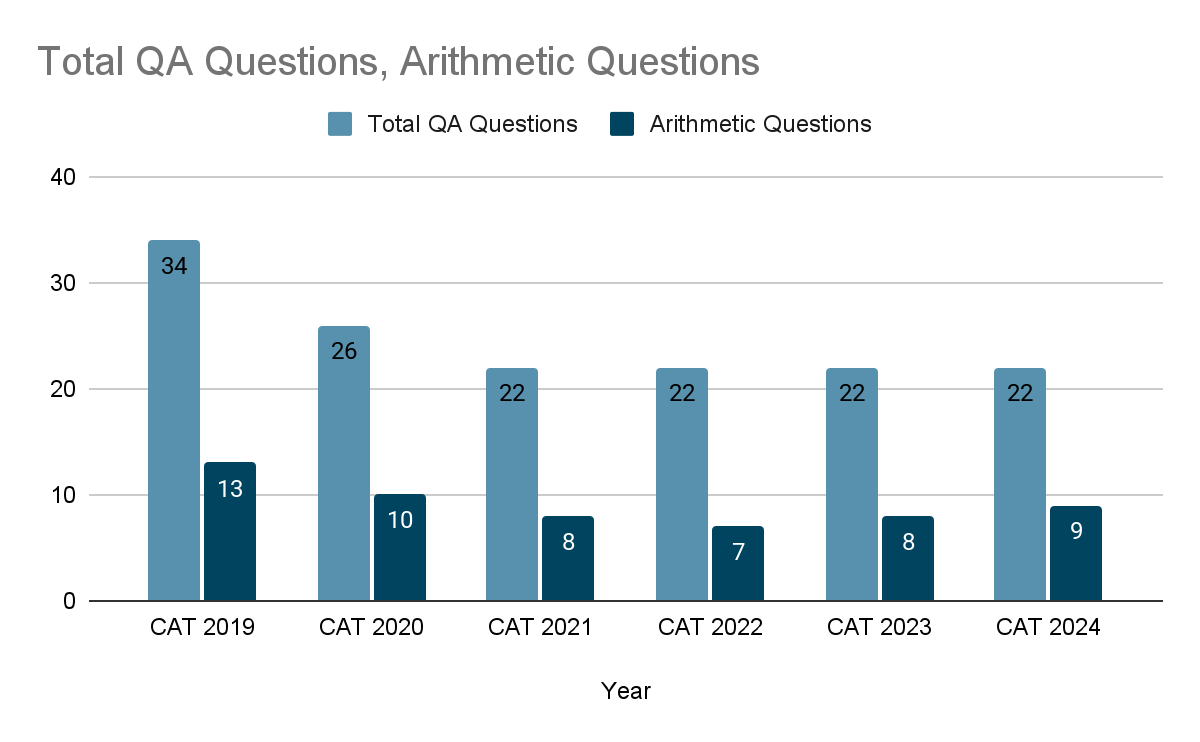Smart preparation is the key to acing the CAT 2025 exam. This is why we have prepared a list of the most important 180+ Arithmetic questions for the CAT 2025.
- The most important questions comprise percentages, time and work, time speed, distances, mixtures, allegations, Simple interest, compound interest, ratio, proportion and some questions of mensuration.
- Practising these questions can help you boost your chances of getting a higher percentile in the final result.
In the CAT exam, we have seen that a minimum of 8 questions are asked from the Arithmetic section, and this makes around 35% of the overall Quant syllabus.
The Quant section of the CAT is divided into 5 different sections: Number System, Arithmetic, Geometry, Modern Mathematics, and Algebra.
The Arithmetic section is also one of the easiest sections of the Quant, which will help you to clear your sectional cutoff and even help you to score in the 90+ percentile.
Also Read

Key Summary
- The CAT Quant Syllabus is divided into 5 different sections, and arithmetic accounts for 35% in the exam.
- More than 8 questions are generally asked from the Arithmetic section in the CAT exam.
Arithmetic Section Year-Wise trends
Looking at the year-wise trends, it is very evident that Arithmetic plays an important role in the CAT exam. Every year, they ask a minimum of 8 questions from the Arithmetic section.
Being one of the easiest sections of Quant, it also helps you to increase your chances of clearing the section cutoff. This consistent representation of Arithmetic in the Quant section is a golden opportunity for you.
Here is a detailed breakdown of how many questions from the Arithmetic topics appeared in past CAT exams:
| Year | Total QA Questions | Arithmetic Questions | Approx. Weightage |
|---|---|---|---|
| CAT 2019 | 34 | 13 | 38% |
| CAT 2020 | 26 | 10 | 38% |
| CAT 2021 | 22 | 8 | 36% |
| CAT 2022 | 22 | 7 | 32% |
| CAT 2023 | 22 | 8 | 36% |
| CAT 2024 | 22 | 9 | 40% |

If attempted with accuracy, then you can increase your chances of getting the 90+ percentile in the CAT. Here are the reviews of Reddit users who advocate arithmetic as a way to secure even the 95+ percentile and the high ROI section of the CAT Quant.
Also Read
CAT MCQs on Arithmetic
Previous years' Question paper for Quant with solutions (2020-2024)
Before diving deep into the preparation, all the CAT aspirants need to go through the previous year's question paper to strengthen their preparation. These papers highlight the pattern of questions asked in the exam. By solving these questions, you can analyse your preparation.
Here are the slot-wise quant question papers with solutions from the 2020 to 2024 CAT:
| CAT 2024 Question Paper | Download PDF | Solution PDF |
|---|---|---|
| CAT 2024 Question Paper with Solutions (Slot 1) – QA | Download PDF | Click Here |
| CAT 2024 Question Paper with Solutions (Slot 2) – QA | Download PDF | Click Here |
| CAT 2024 Question Paper with Solutions (Slot 3) – QA | Download PDF | Click Here |
| CAT 2023 Question Paper | Download PDF | Solution PDF |
|---|---|---|
| CAT 2023 Question Paper with Solutions (Slot 1) – QA | Download PDF | Click Here |
| CAT 2023 Question Paper with Solutions (Slot 2) – QA | Download PDF | Click Here |
| CAT 2023 Question Paper with Solutions (Slot 3) – QA | Download PDF | Click Here |
| CAT 2022 Question Paper | Download PDF | Solution PDF |
|---|---|---|
| CAT 2022 QA Question Paper with Solutions (Slot 1) | Download PDF | Click Here |
| CAT 2022 QA Question Paper with Solutions (Slot 2) | Download PDF | Click Here |
| CAT 2022 QA Question Paper with Solutions (Slot 3) | Download PDF | Click Here |
| CAT 2021 Question Paper | Download PDF | Solution PDF |
|---|---|---|
| CAT 2021 QA Question Paper with Solutions (Slot 1) | Download PDF | Click Here |
| CAT 2021 QA Question Paper with Solutions (Slot 2) | Download PDF | Click Here |
| CAT 2021 QA Question Paper with Solutions (Slot 3) | Download PDF | Click Here |
| CAT 2020 Question Paper | Download PDF |
| CAT 2020 QA Question Paper with Solutions (Slot 1) | Click Here |
| CAT 2020 QA Question Paper with Solutions (Slot 2) | Click Here |
| CAT 2020 QA Question Paper with Solutions (Slot 3) | Click Here |
Also Read
CAT Arithmetic Preparation 2025The Arithmetic section has always been the core of the Quant section, and mastering this section not only ensures a solid percentile in the overall result but also paves the way for securing phenomenal sectional marks. We have curated a 180+ top arithmetic question PDF for you to revise and practice. For CAT 2025, Arithmetic is not just a topic but a gateway to your dream IIM.

Join r/CATpreparation for connecting with your peer candidates
Simple Arithmetic Questions FAQs
FAQs
Ques. Was CAT 2025 Tough?
Ans. Looking at the year-wise trend of the CAT exam, the exam usually ranges from moderate to difficult, depending on the slot. The CAT 2023 was difficult, but the next 2024 CAT was moderately easy compared to 2023, and this time we are expecting the exam to be moderate to difficult. However, smart preparation and consistent practice can help you score even in the 99+ percentile even in your first attempt.
Ques. How many Arithmetic Questions for the CAT?
Ans. The trend from 2022 to 2024 shows a gradual increase in the number of arithmetic questions in the CAT exam, so we expect a total of 10 to 12 questions might come from the arithmetic quant section. However, it is also advised to prepare other topics of quant to secure a better sectional cutoff and overall percentile.
Ques. Which IIM sets the paper for CAT 2025?
Ans. IIM Kozhikode is going to set the paper for the CAT 2025, and the exam is scheduled for November 20, 2025.







Comments